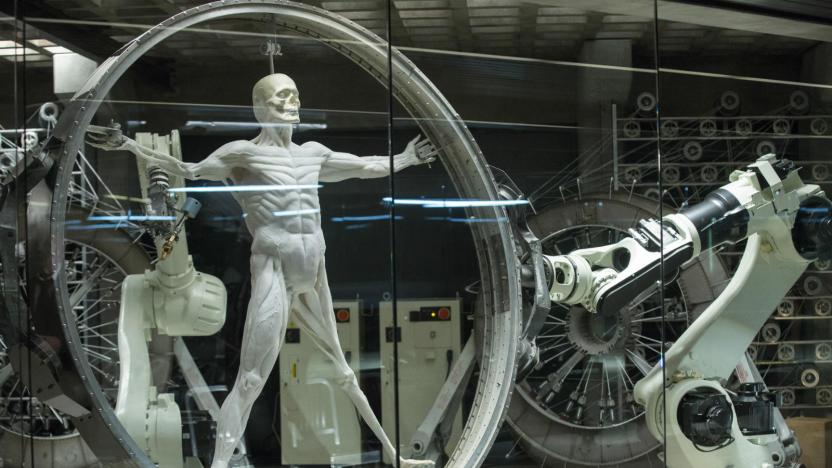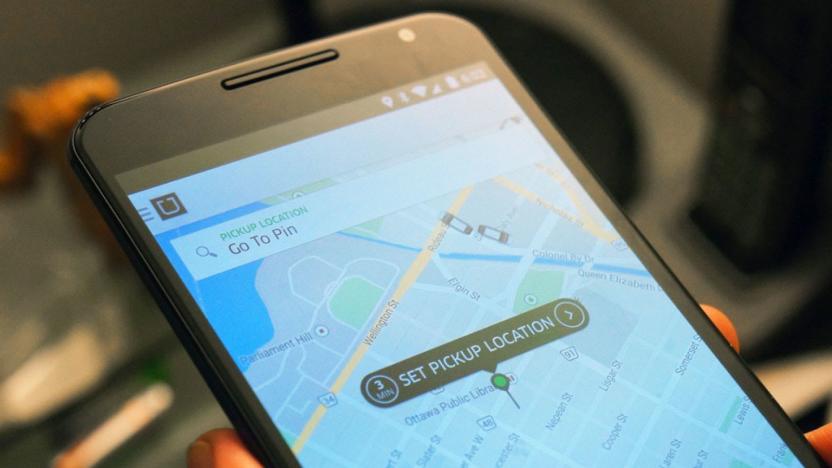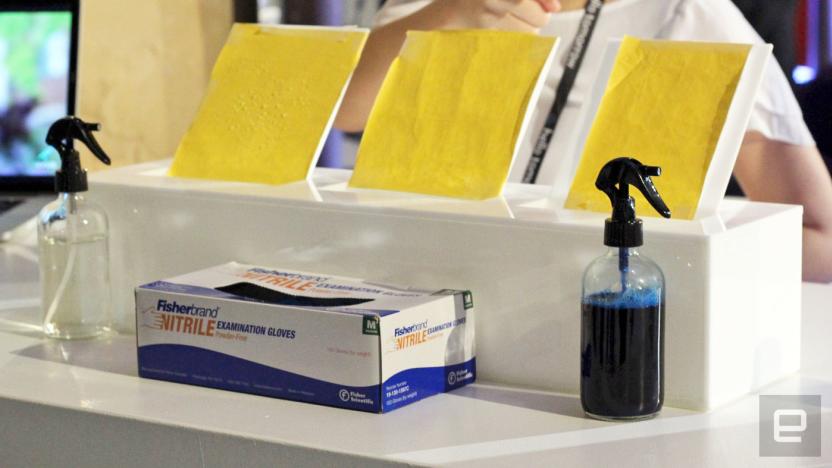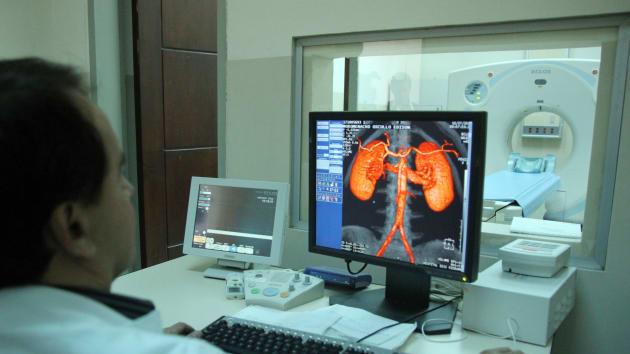ColumbiaUniversity
Latest

FCC Chairman Pai appoints a new chief technology officer
FCC Chairman Ajit Pai announced that Eric Burger would be joining the commission as its new chief technology officer. He's set to take over the position this month. Burger will be replacing Henning Schulzrinne who is returning to a Columbia University professorship after serving a second round as CTO since the end of 2016. He was also the FCC CTO from 2011 to 2014.

Synthetic muscle breakthrough could lead to 'lifelike' robots
A breakthrough in soft robotics means scientists are now one step closer to creating lifelike machines. Researchers at Columbia Engineering have developed a 3D printed synthetic tissue that can act as active muscle. The material, which can push, pull, bend, and twist (thanks to its use of silicone rubber and ethanol-dispensing micro-bubbles) is also capable of carrying 1,000 times its own weight. Not only could the invention result in super-strong machines (like a Terminator that works in manufacturing), but it will also release soft robots from their current shackles.

Car ownership could decline thanks to Uber and Lyft
While it may seem logical that people will own fewer cars as ride-hailing services like Lyft and Uber gain more traction, there hasn't been a way to study any potential effect. Then Uber and Lyft left Austin, Texas for about a year. A group of researchers from University of Michigan Transportation Research Institute (UMTRI), Texas A&M Transportation Institute, and Columbia University found that the presence of ride-sharing companies can change car ownership behavior, which could eventually lead to fewer personal cars in the future.

Scientists may have found a Neptune-sized alien moon
Astronomers have found an abundance of exoplanets, but no exomoons. Despite ongoing efforts, the tiny celestial bodies have just been too elusive to detect using modern technology. However, researchers might have just hit paydirt. They've used Kepler Space Telescope data to discover signs of what looks like a Neptune-sized moon orbiting a planet in the Kepler-1625 system, 4,000 light years away from Earth. They were tipped off to the companion when they noticed dips in brightness (indicative of an object transiting in front of a star) around a planet during three of its transits. It's a very promising piece of evidence, but we wouldn't bet money just yet -- there's some homework left to do before the discovery is validated.

Blue dye could help keep Ebola doctors safe
If you're unfortunate enough to wind up in hospital with a dangerous infectious disease like Ebola, then keep an eye on what your doctors are wearing. If their hazmat suits are smeared with blue dye that gently evaporates as they work with you, you can rest easy. If they're sporting the odd tint, it means that they're taking proper precautions and keeping their biohazard gear nice and clean. It also means that they're using Kinnos Highlight, a new wonder dye created by three students out of Columbia University.

Flexible lens sheets could change way cameras see
Cameras are already embedded in a lot of devices, but what you could wrap them around things like a "skin?" That's the premise of "flexible sheet cameras" developed by scientists at Columbia University. Rather than having just a single sensor, the devices use an array of lenses that change properties when the material is bent. The research could lead to credit card-sized, large-format cameras that you zoom by bending, or turn objects like cars or lamp posts into 360-degree VR cameras.

Facebook created a super-detailed population density map
Facebook's quest to get the world online is paying some unexpected dividends. Its Connectivity Lab is using image recognition technology to create population density maps that are much more accurate (to within 10m) than previous data sets -- where earlier examples are little more than blobs, Facebook shows even the finer aspects of individual neighborhoods. The trick was to modify the internet giant's existing neural network so that it could quickly determine whether or not buildings are present in satellite images. Instead of spending ages mapping every last corner of the globe, Facebook only had to train its network on 8,000 images and set it loose.

The world's thinnest light bulb is made from graphene
Forget LED light bulbs... in the future, your lighting may be made from carbon. Columbia University researchers have built a light bulb chip that superheats graphene to produce illumination. While that's the same basic concept that you see in an incandescent bulb, the graphene filament measures just one atom thick -- this is the world's thinnest light bulb, and may be close to being the thinnest possible. It's transparent, too, which could suit it to see-through displays.

This video camera is powered by light
No, you haven't stumbled across an internet video from 1997 -- that's the output of one of the cleverest cameras you'll see in a while. Columbia University researchers have developed a self-powered camera whose pixels both record light and turn it into electricity. The trick is the use of photodiodes (which are common in both cameras and solar panels) that are permanently set to collect energy, not simply conduct it.

Your smart TV can be hacked over the air, but it's not likely
It only makes sense that putting a TV online theoretically exposes it to hackers, but it's now clear that those hacks don't have to go through conventional internet pipelines. A team of Columbia University researchers has published details of a vulnerability in an interactive TV standard (HbbTV) that lets evildoers hijack your smart TV and other devices in your home network so long as you tune into a specific over-the-air digital channel. Attacks can run undetected in the background, and the nature of the broadcasts makes it difficult or impossible to trace the culprit. Reportedly, the only surefire remedies are to cut off broadcast-based web content altogether, monitor for unusual spikes in network activity or notify users when apps launch.

Students get iOS apps running (slowly) on Android
Running apps from one mobile platform on another is theoretically great for boosting your app selection, but it's not a trivial task -- even BlackBerry's Android support is rough. However, some Columbia University students have managed the daunting feat of running iOS apps on Android with their Cider compatibility layer. This isn't a regular emulator or virtual machine, like you might expect. Instead, it simply tricks apps into believing that they're in a native environment: they adapt code on the fly to make it work with Android's kernel and programming libraries. Even 3D benchmarks run properly.

Health care outlets pay $4.8 million after 6,800 patient records leak on the web
Want to know why health care institutions can be antsy about making their patient data available online? Here's why: Columbia University and the New York and Presbyterian Hospital have paid a total of $4.8 million to settle charges after they inadvertently leaked the records of 6,800 patients to the web in 2010. The organizations allegedly didn't do enough to identify systems that had sensitive info, leaving them unprepared when a physician switched off a personal server that was keeping the records private. Both outlets are overhauling their policies in the wake of the settlement, so a repeat incident is less likely. Still, the breach is a not-so-friendly reminder that there are big risks to putting medical histories on networked computers -- your data is only as safe as the system it's on. [Image credit: Presidencia de la Republica del Ecuador, Flickr]

World's smallest FM transmitter built with graphene, ruined by Psy
Researchers have been using graphene to develop an assortment of technologically advanced things for a while, from camera sensors and contact lenses all the way to frickin' lasers. That's why it's not a surprise to see a group of engineers from Columbia University create the world's smallest FM transmitter using the atom-thick material. The end product isn't just for show, either, as it can pump tunes over the airwaves to a regular FM radio -- the team even used Gangnam Style to prove that it works. As interesting as the teensy transmitter is, the engineers have no plans to build a radio for ants, and this is merely part of a larger study into nano-electromechanical systems. Now all we need is for someone to make a tiny violin and a pair of tweezers small enough for us to play.

Columbia University's low-cost robotic arm is controlled by facial muscles, we go face-on (video)
We've seen Emotiv's Epoc headset control cars and trapeze acts, but now a small posse of students at Columbia University is teaching it how to control a robotic arm. The appendage, aptly named ARM for Assistive Robotic Manipulator, was envisioned as a wheelchair attachment to help the disabled. According to the team, the goal was to keep costs in the neighborhood of $5,000 since insurance outfits Medicare and Medicaid won't foot a bill for assistive tech that's much more than $10,000. To keep costs low, the crew built the limb from laser cut wood, and managed to keep the final price tag at $3,200. Since picking up EEG signals and interpreting them accurately can be tricky, the group says it settled on monitoring EMG waves, which are triggered by muscle movements, for additional reliability. Lifting your eyebrows makes the device open its grip, clenching your teeth shuts it and moving your lips to the left and right twists the claw, while other motions are currently handled by using a PlayStation 2 controller. In the lab, the contraption has seven degrees of freedom, but it was reduced to five when we took it for a spin. It was hit or miss when this editor put the headgear on, between making sure facial gestures were spot on and the equipment's attempts to pick up clear signals.%Gallery-187534%

The future of higher education: reshaping universities through 3D printing
Featuring four towering limestone columns and classic Flemish-bond brickwork, the century-old Mackay School of Mines Building at the University of Nevada, Reno, has long served as a bastion of Silver State history. Named after Irish immigrant and "Comstock Lode King" John Mackay, notable touches such as a cast bronze statue designed by Mount Rushmore sculptor Gutzon Borglum just outside the building helped it earn a spot in the National Register of Historic Places. Within its oak doors, however, are the makings of an intriguing experiment that's decidedly more new school. Like a mini museum, a collection of 3D-printed models are displayed within the building's sunlit, three-story atrium -- attracting a mix of students and teachers. Even more popular than the displays of plastic gears and molecule models, however, are the two 3D printers that made them: a professional-grade Stratasys uPrint SE Plus and a hobbyist 3DTouch machine by 3D Systems Corporation.

Researchers expose printer vulnerability, turn LaserJets into literal time bombs (update)
Your precious printer might seem innocuous but, in reality, it could be a ticking time bomb just waiting for some hacker to trigger it. Oh, and we mean that not just figuratively, but literally as well -- they could actually be caused to burst into flames by some ne'er-do-well half-way around the globe. Of course, the potential doesn't end at remote arson, an attacker could easily gain access to a network or steal documents, and hijacking the lowly device would require little more than printing an infected file. So far researchers at Columbia University have only managed to exploit the hole on HP printers, but it's possible (if not likely) that others are also affected. Most printers look for a firmware update every time they receive a job but, for some reason, they rarely check the validity of an incoming file. A fake upgrade could easily be attached to a file sent over the internet, directly to a device -- no need to even trick anyone. HP says it's taking the issue very seriously and looking into the vulnerability, though, it says newer devices aren't affected (a claim the researchers challenge). For a lot more detail on the what and how check out the source link. Update: HP (unsurprisingly) issued a rebuttal. It's working up a firmware update right now for certain flaws, but it'll have you know that "no customer has reported unauthorized access."

$1 chip tests for HIV in 15 minutes flat, fits in your wallet
Getting tested for STDs used to mean a doctor's visit, vials of blood, and days, weeks, or even months of anxiously waiting for results. mChip aims to change all that, while simultaneously ridding your brain of viable excuses not to get tested. It works as such: one drop of blood goes on the microfluidics-based optical chip, 15 minutes pass, and boom, the AmEx-sized device will confirm whether or not you have syphilis and / or HIV. The bantam gizmo is practically foolproof, as reading the results doesn't require any human interpretation whatsoever. Plus, it's cheap -- cheaper than a coffee at Starbucks. One dollar cheap. Researchers at Columbia University claim the mChip has a 100 percent detection rate, although there's a four to six percent chance of getting a false positive -- a stat similar to traditional lab tests. As you'd likely expect, there's hope that the inexpensive mChip will help testing efforts in places like Africa to detect HIV before it turns into AIDS. Next stop: the self-service pharmacy at CVS?

IBM's Jeopardy-winning supercomputer headed to hospitals. Dr. Watson, we presume?
We always knew that Watson's powers extended well beyond the realm of TV trivia, and now IBM has provided a little more insight into how its supercomputer could help doctors treat and diagnose their patients. Over the past few months, researchers have been stockpiling Watson's database with information from journals and encyclopedias, in an attempt to beef up the device's medical acumen. The idea is to eventually sync this database with a hospital's electronic health records, allowing doctors to remotely consult Watson via cloud computing and speech-recognition technology. The system still has its kinks to work out, but during a recent demonstration for the AP, IBM's brainchild accurately diagnosed a fictional patient with Lyme disease using only a list of symptoms. It may be another two years, however, before we see Watson in a white coat, as IBM has yet to set a price for its digitized doc. But if it's as sharp in the lab as it was on TV, we may end up remembering Watson for a lot more than pwning Ken Jennings. Head past the break for a video from the University of Maryland School of Medicine, which, along with Columbia University, has been directly involved in IBM's program.

OnLive shows off UI and iPhone use in marathon tech demo (video)
Sure, OnLive has already done live demos of its "cloud gaming" service, but it never hurts to get another comprehensive 48-minute video on the subject. In a presentation at Columbia University, CEO Steve Perlman goes over the nitty gritty of how game streaming works, the OnLive user interface (11:53), an inevitable Crysis Wars demo (16:35), Brag Clips (17:49), and of course the iPhone app (19:31). Though cellphone integration is still limited to primarily spectating and social networking functions, PCs and Macs can get gaming via a 1MB browser plugin, or you can grab the microconsole streaming box for your TV, which Steve suggests might be given away for free with OnLive subscriptions. If you have any more unanswered questions, check out the audience Q&A at 33:14, and the full vid awaits after the break.

Meet MAYA-II, the new DNA computer that can play Tic-Tac-Toe
While strands of DNA may be able to pick fights with other strands, one thing that they can't do yet is play computer games -- that is, until now. In what appears to be an early proof-of-concept for DNA computing, scientists at Columbia University and the University of New Mexico have created a basic computer, called the MAYA-II, which has a molecular array of YES and AND logic gates made up of 100 DNA circuits. This allows the MAYA-II to play a complete game of Tic-Tac-Toe against a human opponent, and apparently nearly always win. However, this isn't exactly a fair test, given that the MAYA-II always goes first, and always opens with the center square. Still, even though each move takes 30 minutes to complete, the lead researcher on the project, Dr. Joanna Macdonald of Columbia, says that a DNA computer would be perfect for injection into human subjects to combat disease, because in theory, it would be able to "diagnose and kill cancerous cells or monitor and treat diabetes by dispensing insulin when needed." Useful applications aside, we're ready to take on the MAYA-II in Connect Four whenever Dr. Macdonald thinks it's ready.[Via MedGadget]











